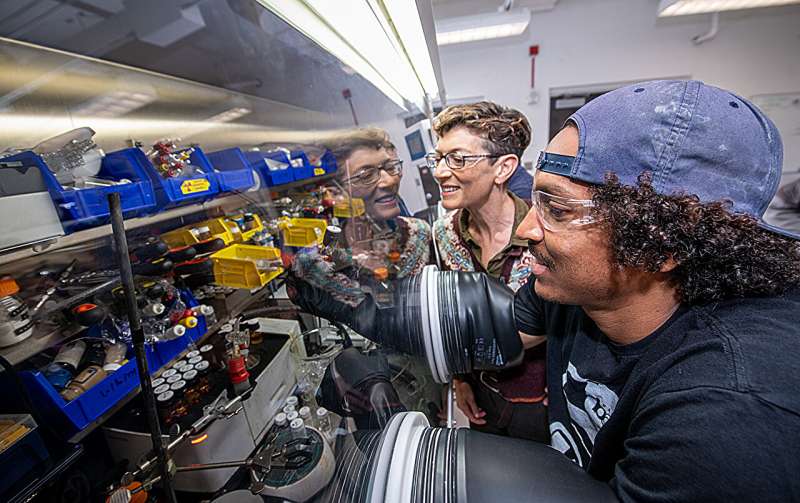This article has been reviewed according to Science X's editorial process and policies. Editors have highlighted the following attributes while ensuring the content's credibility:
fact-checked
peer-reviewed publication
trusted source
proofread
Study introduces a cleaner way to produce ammonia at room temperature and pressure

Ammonia is the starting point for the fertilizers that have secured the world's food supply for the last century. It's also a main component of cleaning products, and is even considered as a future carbon-free replacement for fossil fuels in vehicles.
But synthesizing ammonia from molecular nitrogen is an energy-intensive industrial process, due to the high temperatures and pressures at which the standard reaction proceeds. Scientists from the Department of Energy's Lawrence Berkeley National Laboratory (Berkeley Lab) now have a new way to produce ammonia that works at room temperature and pressure.
Since 1909, the industry-wide standard for synthesizing ammonia has involved converting molecular nitrogen (dinitrogen, N2) via a reaction with hydrogen gas using metal-based catalysts, known as the Haber-Bosch process. Polly Arnold, a senior staff scientist and the director of the Chemical Sciences Division at Berkeley Lab, has found that instead, catalysts made from abundant so-called rare-earth metals can facilitate this reaction at room temperature.
"Nobody expected rare earth metals to do this reaction. They've expanded our arsenal of potential ambient condition catalysts," says Arnold, who is also a professor of chemistry at UC Berkeley.
Rare-earth metals are the silvery-white, soft, heavy elements that make up all the non-radioactive metals from the group at the bottom of the periodic table, and have attracted plenty of interest for applications in electronics, lasers, and magnetic materials.
"Despite their name, rare-earth metals are not actually rare," said Anthony Wong, a postdoctoral researcher in Arnold's group at UC Berkeley and affiliate in Berkeley Lab's Chemical Sciences Division and lead author on the paper in Chem Catalysis that describes the work. "Some are nearly as common as copper, and their salts are less toxic than metals that are already used in catalysis," he added.
The exciting thing about rare-earth metals, from a fundamental perspective, is that they have a set of additional electrons that their transition metal counterparts do not have. This gives them interesting opto-magnetic properties – but chemists don't fully understand if and how the electrons might be used in reactions. Examining reactions involving rare earth metals is an attractive tool for understanding their electronic structures and how their structures can apply to new reactivity.

Rare earths have been known to bind molecular nitrogen since the 1990s. However, until now, researchers have not been able to use them to create nitrogen-functionalized chemicals like ammonia or amines catalytically from N2.
Wong, Arnold, and their colleagues designed compounds that joined two rare-earth metals with simple linkages made from phenolates based on a simple antioxidant used widely in food. The resulting structure formed a rectangular cavity.
Molecular nitrogen that diffused into the cavity formed bonds with the metals at either end, which activates the gas. Then, electrons introduced into the cavity from a potassium source attacked the activated nitrogen, cleaving its bonds. In all its standard forms, converted nitrogen forms three covalent bonds to hydrogen atoms, or other reactants, resulting in symmetrical ammonia or amines.
"Our catalysts activate and hold the dinitrogen, while different reagents come in and react to form different products," said Arnold. She intends next to use electrodes instead of the potassium reagent as a source of electrons, since these can be renewable if they derive from solar cells, for example.
The scientists will next explore how to use rare earths to synthesize additional nitrogen-containing products by tuning the shape and size of the letterbox-shaped cavity. "Our next step is to explore and understand which rare-earth metal properties impact the chemistry," said Wong.
The new process is not going to replace the widespread industrial Haber-Bosch process. Global ammonia production has hovered around 200 million metric tons annually since 2020, and the existing tools are optimized and extremely efficient at large scale. But the process consumes around 2% of the world's energy use and creates geographic inequities in the availability of ammonia.
"That's not food justice," said Arnold. Wong added, "We need better ways of producing ammonia that are less energy intensive and can be conducted at ambient temperatures and pressures to help with food and energy security." Their patented technology could bring fertilizers and chemically specific nitrogen products to regions without a pipeline, and at a much lower cost.
Some of this research was conducted at the Advanced Light Source, a Department of Energy Office of Science User Facility located at Berkeley Lab.
More information: Anthony Wong et al, Catalytic reduction of dinitrogen to silylamines by earth-abundant lanthanide and group 4 complexes, Chem Catalysis (2024). DOI: 10.1016/j.checat.2024.100964
Journal information: Chem Catalysis
Provided by Lawrence Berkeley National Laboratory





















